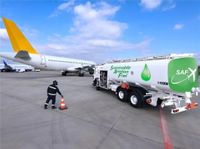In a move that could reshape the future of sustainable aviation, Honeywell has announced its technology will play a central role in Syzygy Plasmonics’ pioneering renewable Sustainable Aviation Fuel (SAF) project in Uruguay. The collaboration is set to debut at Syzygy’s modular commercial plant, NovaSAF-1, located in Durazno, Uruguay, with expectations to produce over 350,000 gallons of SAF annually—a significant step for the burgeoning green fuels sector.
According to Hydrocarbon Engineering, the NovaSAF-1 facility isn’t just another renewable fuel plant. It’s the world’s first electrified biogas-to-SAF facility, harnessing dairy waste and renewable energy to create jet fuel. The project’s ambitions are anything but modest. The NovaSAF platform, as described by Syzygy Plasmonics CEO and co-founder Trevor Best, is designed to be replicated at more than 50,000 biogas sites globally, dramatically expanding the potential reach and impact of this technology.
“Our innovative NovaSAF platform helps meet the growing demand for sustainable aviation fuels by achieving both high volumes and low price points, even as low as Jet-A parity under the right conditions,” Best said, as quoted by Hydrocarbon Engineering. He added, “With Honeywell’s hydrocracking technology, we can accelerate the development of our modular NovaSAF-1 plant, which will serve as a repeatable, scalable model for the future. This plant will show the world how profitable it can be to produce SAF from biogas waste streams combined with renewable energy.”
The timing of the announcement couldn’t be more pressing. As traditional feedstocks for renewable fuels become increasingly scarce, the aviation industry faces mounting pressure to decarbonize and find sustainable alternatives. The International Energy Agency (IEA) estimates that by 2030, waste- and non-food crop-based biofuels will account for over 40% of global biofuel demand. This projection underscores the urgency for innovative solutions like those being piloted in Uruguay.
Honeywell’s role in the project is significant. The company is providing its UOP Fischer-Tropsch (FT) Unicracking technology, a hydrocracking process that Honeywell has refined and pioneered for more than 70 years. According to Rajesh Gattupalli, president of Honeywell UOP, the partnership represents a leap forward in both technology and scalability. “Syzygy’s modular construction paired with our proven, innovative technology demonstrates how biogas-to-SAF facilities can become more achievable and help improve waste-to-clean-energy conversion. The combination helps alleviate two major challenges with SAF production and scale – cost and feedstock diversity,” Gattupalli said in a statement reported by Hydrocarbon Engineering.
But how does this all work? The NovaSAF-1 plant will use biogas derived from dairy waste as its primary feedstock, converting it into SAF through a process powered by renewable electricity. This approach not only diverts waste from landfills but also taps into a renewable energy source, creating a closed-loop system that maximizes environmental benefits. The modular design of Syzygy’s platform is another key innovation, allowing for rapid deployment and scalability. The idea is that these compact, off-site built modules can be quickly installed at biogas sites or refineries, reducing construction risk and enabling faster start-up compared to conventional refinery projects—a point emphasized by both Syzygy and Honeywell in their announcements.
“Honeywell continues to build on our hydrocracking technology, which we have pioneered for more than 70 years, while advancing the production of lower-carbon fuels for aviation,” Gattupalli said, highlighting the company’s long-standing expertise in the field. The modular solutions are designed to be versatile, accommodating a range of feedstocks and making the technology attractive to a global market where resource availability varies widely.
The NovaSAF platform’s replicability is perhaps its most game-changing feature. With over 50,000 biogas sites worldwide, the potential for scaling up production is enormous. If even a fraction of these sites adopt the NovaSAF model, the impact on global SAF supply could be transformative, helping the aviation sector inch closer to its net-zero emissions targets. Best is confident about the platform’s commercial viability, noting, “This plant will show the world how profitable it can be to produce SAF from biogas waste streams combined with renewable energy.”
The economics of SAF production have long been a sticking point. Traditional SAF, often made from limited feedstocks like used cooking oil or animal fats, tends to be more expensive than conventional jet fuel, known as Jet-A. Syzygy’s approach aims to break this cost barrier. By using abundant waste streams and renewable power, the company believes it can achieve price parity with Jet-A under the right market conditions—a claim that, if realized, could be a game-changer for airlines and the broader transportation sector.
The project also addresses another critical challenge: feedstock diversity. As Rajesh Gattupalli pointed out, “The combination helps alleviate two major challenges with SAF production and scale – cost and feedstock diversity.” By leveraging various types of biogas and renewable energy, the NovaSAF platform isn’t tied to a single resource, making it more resilient to market fluctuations and supply constraints.
Honeywell’s broader strategy to meet the rapidly growing demand for renewable fuels includes offering modular renewable fuels technology that can be built off-site and quickly installed at refineries. This approach not only lowers risk but also accelerates start-up times, a crucial advantage in a market hungry for immediate solutions to carbon emissions.
Industry observers are watching closely. The aviation sector, responsible for about 2-3% of global CO2 emissions, is under increasing pressure from regulators, investors, and consumers to decarbonize. Sustainable aviation fuel is widely viewed as one of the most promising near-term solutions, but scaling up production to meet global demand has proven challenging. Projects like NovaSAF-1, with their focus on modularity, replicability, and cost-effectiveness, could offer a template for others to follow.
Of course, challenges remain. Achieving Jet-A price parity depends on a complex interplay of factors, including energy prices, feedstock availability, regulatory incentives, and technological efficiency. Yet, the NovaSAF-1 project represents a bold step forward, demonstrating that with the right combination of innovation and partnership, the aviation industry’s green ambitions might just be within reach.
As the world looks to 2030 and beyond, the success of Syzygy and Honeywell’s collaboration in Uruguay may well serve as a bellwether for the future of sustainable flight—showing that what was once a distant goal is now, perhaps, just around the corner.

